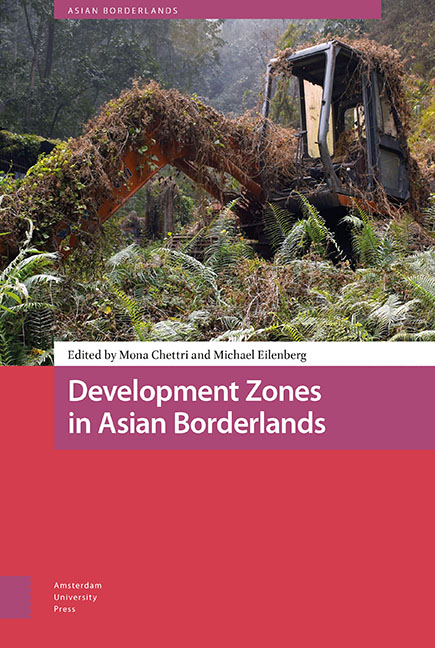Book contents
- Frontmatter
- Contents
- List of Figures and Tables
- Acknowledgements
- Introduction: Enclave Development and Socio-spatial Transformations in Asian Borderlands
- 1 Post-disaster Development Zones and Dry Ports as Geopolitical Infrastructures in Nepal
- 2 Onwards and Upwards: Aerial Development Zones in Nepal
- 3 Casinos as Special Zones: Speculative Development on the Nation’s Edge
- 4 Thinking the Zone: Development, Climate, and Heterodystopia
- 5 From Shangri-La to De facto SEZ: Land Grabs from “Below” in Sikkim, India
- 6 Development Zones in Conflict-Affected Borderlands: The Case of Muse, Northern Shan State, Myanmar
- 7 Smart Enclaves in the Borderland: Digital Obligations in Northeast India
- 8 Post-Disaster Economies at the Margins: Development, Profit, and Insecurities Across Nepal’s Northern Borderlands
- 9 Development from the Margins: Failing Zones and Suspended Development in an Indonesian Border Village
- 10 From Boom to Bust – to Boom Again?: Infrastructural Suspension and the Making of a Development Zone at the China-Laos Borderlands
- 11 Genealogies of Extraction: De Facto Development Zones in the Indonesian Borderlands
- Notes on Contributors
- Index
4 - Thinking the Zone: Development, Climate, and Heterodystopia
Published online by Cambridge University Press: 18 June 2021
- Frontmatter
- Contents
- List of Figures and Tables
- Acknowledgements
- Introduction: Enclave Development and Socio-spatial Transformations in Asian Borderlands
- 1 Post-disaster Development Zones and Dry Ports as Geopolitical Infrastructures in Nepal
- 2 Onwards and Upwards: Aerial Development Zones in Nepal
- 3 Casinos as Special Zones: Speculative Development on the Nation’s Edge
- 4 Thinking the Zone: Development, Climate, and Heterodystopia
- 5 From Shangri-La to De facto SEZ: Land Grabs from “Below” in Sikkim, India
- 6 Development Zones in Conflict-Affected Borderlands: The Case of Muse, Northern Shan State, Myanmar
- 7 Smart Enclaves in the Borderland: Digital Obligations in Northeast India
- 8 Post-Disaster Economies at the Margins: Development, Profit, and Insecurities Across Nepal’s Northern Borderlands
- 9 Development from the Margins: Failing Zones and Suspended Development in an Indonesian Border Village
- 10 From Boom to Bust – to Boom Again?: Infrastructural Suspension and the Making of a Development Zone at the China-Laos Borderlands
- 11 Genealogies of Extraction: De Facto Development Zones in the Indonesian Borderlands
- Notes on Contributors
- Index
Summary
Abstract
This chapter interrogates an emergent genre of development zone in the India-Bangladesh borderlands that seek to instil resilience in climatevulnerable populations. Unlike development zones framed in relation to development as economic growth, these zones venture a darker vision of life in a warming world – one where portable technologies become necessary for managing a future of climate chaos. I propose, following Foucault, understanding these projects as heterodystopias: spaces managed as and in anticipation of a world of dystopian climate crisis that are at once, stages for future interventions and present-day spectacles of climate security. Heterodystopia provides an analytic for diagnosing the visions of time, space, and development embedded in these and other securitised framings of the future.
Keywords: climate change, development, resilience, security, Bangladesh, South Asia
In the spring of 2015, while working in the countryside of Munshiganj in the borderlands of southwestern Bangladesh, my colleague and I came across a strange and visually striking project rising incongruously from the flat delta landscape. It was an earthen mound, or mattir killa, meant to be used as a storm shelter. The mound was fourteen feet in height and a half-acre in size. It had been constructed in 2011 in the aftermath of Cyclone Aila (in 2009), which caused widespread infrastructural damage and displacement throughout the region. The killa, built by a local NGO and financed by a large international NGO, formed part of a vast wave of new projects in the region designed to address disaster preparedness and climate change. What seemed strange about the project was not only its visual appearance, climbing abruptly from its otherwise horizontal surroundings, but its stated purpose: what kind of shelter could this raised mound provide? In contrast to the concrete cyclone shelters that dot the region, the killa seemed to offer limited protection. Moreover, though nominally a public good, it had been built on private land. Striking up a conversation with the farmer who owned the land and whose home stood in the killa's shadow, we asked about the project and its uses. He lived some distance from the nearest cyclone shelter, so when the storms came, he claimed, his family and livestock sheltered on the killa. But he also added, “In the future, when we are surrounded by water, the children will go up there to live.”
- Type
- Chapter
- Information
- Development Zones in Asian Borderlands , pp. 97 - 116Publisher: Amsterdam University PressPrint publication year: 2021

